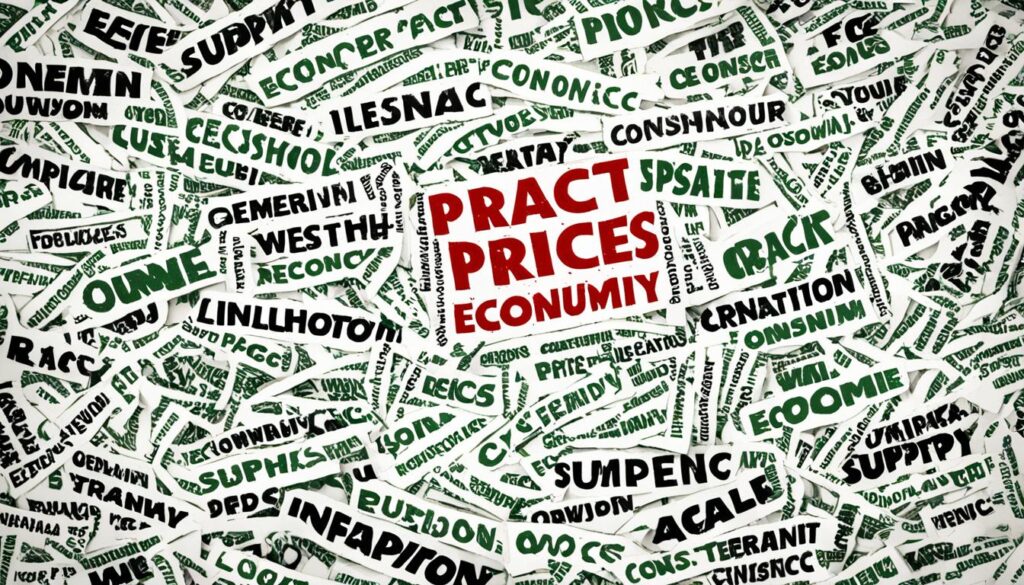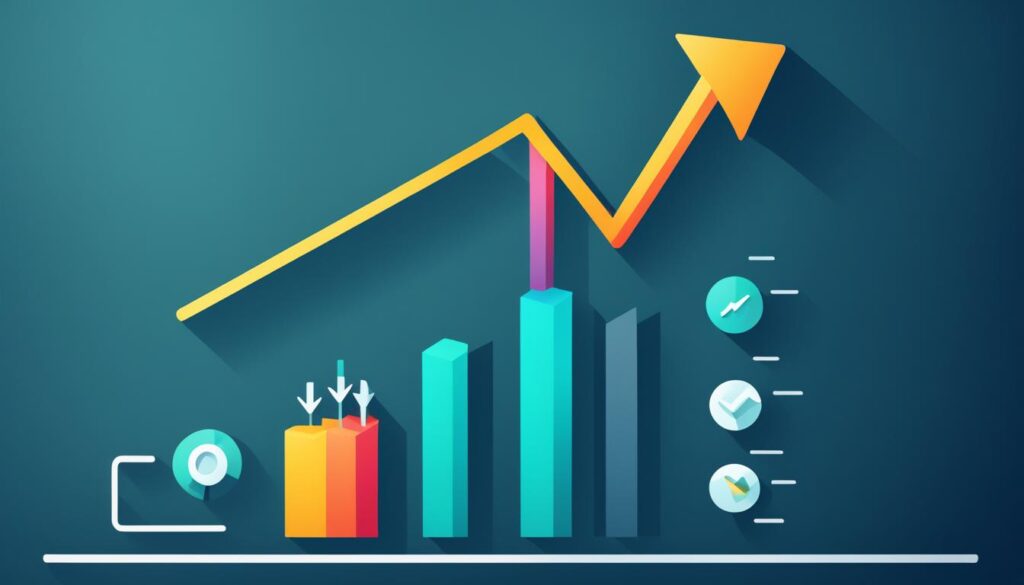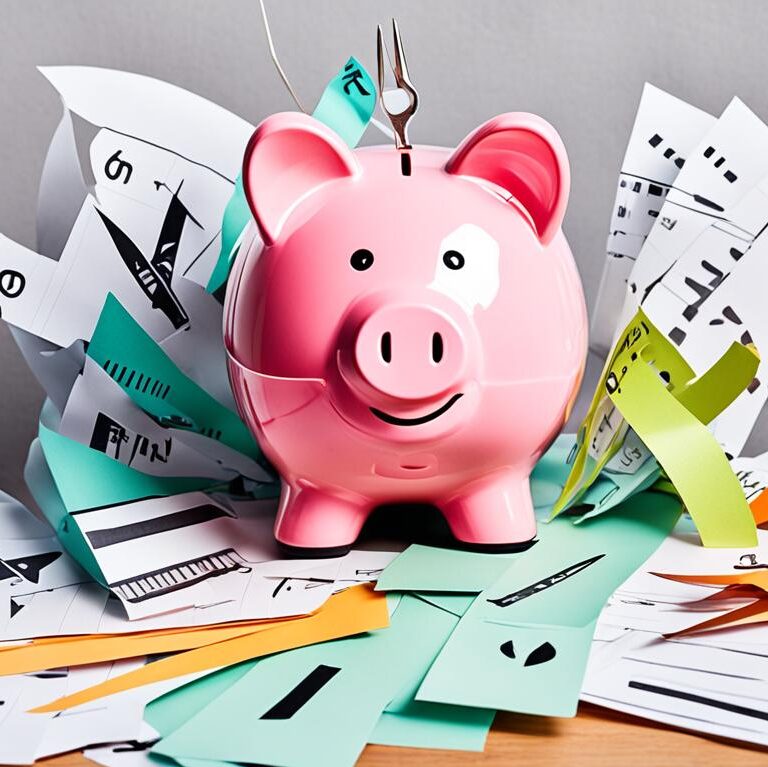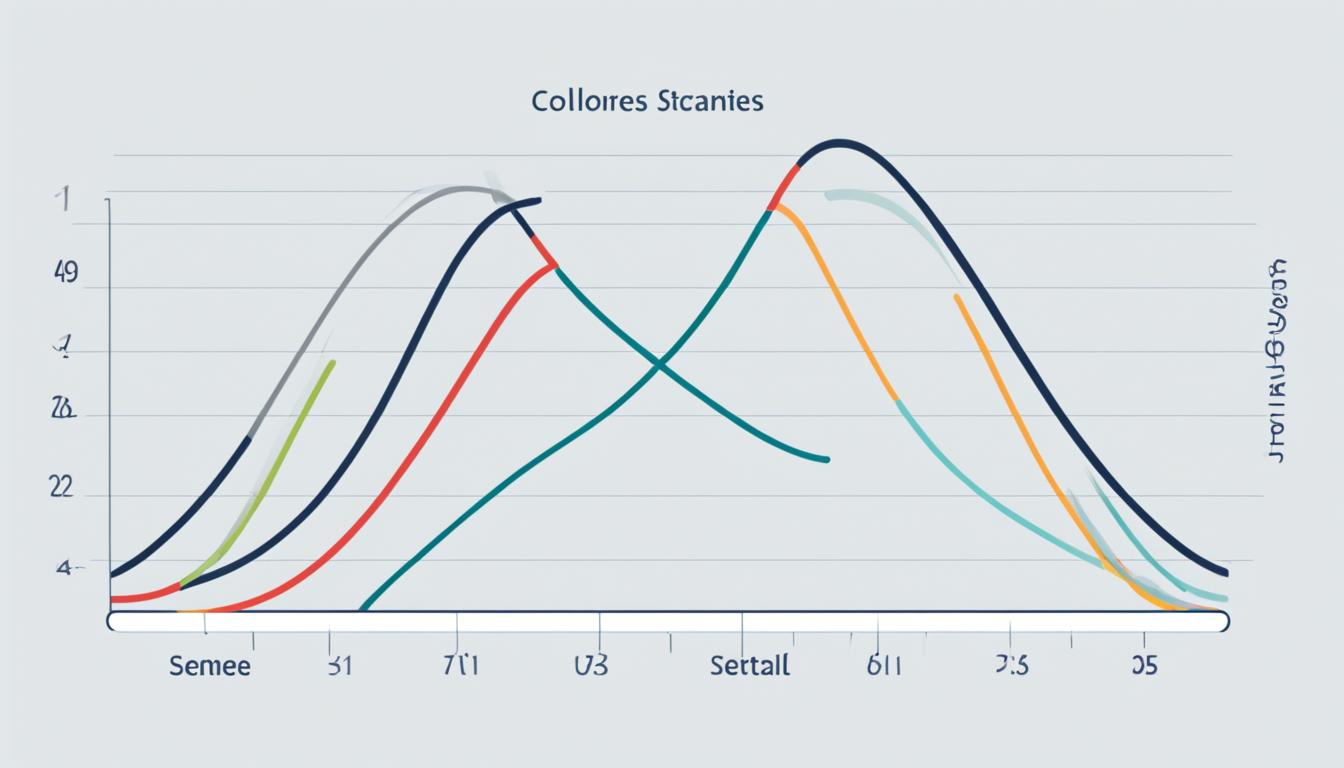“As an Amazon Associate I earn from qualifying purchases.”
On the global stage, the dance of economic signals is complex. A wrong step can affect markets and families. Right now, after the pandemic, we see the real GDP growth slowing to 0.7% in 2024 from 2.8% growth the previous year1. This shows how important it is to understand inflation vs recession.
Knowing about economic downturns and business cycles is key. It helps you know when to be careful or take risks. With the Fed keeping rates between 5.25%-5.5% until mid-20241, it’s a signal to be cautious. Also, the U.S. federal deficit is expected to drop to 5.9% of GDP, showing tighter spending1.
Inflation might stay above 2% through 2024, with core PCE prices going up by 2.4%1. Job market might also see changes, with unemployment possibly hitting mid-4% by year’s end1. The housing sector is facing declines due to high mortgage rates1, and the commercial real estate is under pressure too1.
Key Takeaways
- Grasping the interplay of inflation vs recession is vital in today’s volatile economic landscape.
- Monitoring economic indicators can help you stay ahead of an economic downturn.
- A cautious approach to fiscal policy and personal finance prepares you for ripples in the business cycles.
- Understanding the Federal Reserve’s monetary policy enables informed decisions amidst changing interest rates.
- Being aware of sectors impacted by economic shifts, such as housing and commercial real estate, is essential.
- Preparing for potential increases in unemployment rates is a prudent measure in maintaining financial stability.
Understanding Inflation and Its Economic Impacts
Inflation is a big deal in the economy. It shows how buying power changes and checks on demand. The consumer price index, or CPI, helps us see how the value of money compares to the cost of goods. Inflation is complex and understanding it fully requires knowing its causes and effects.
The Dynamics of Rising Prices
The Federal Reserve aims to keep inflation around 2%. This suggests a healthy economy2. As of February 2024, the U.S. saw inflation at 3.2%, showing the economy’s reaction to supply, demand, and other factors2. Inflation can rise from more money, higher consumer demand, or scarcity of materials2. The U.S. faced increased inflation after the pandemic. Disrupted supply chains and increased spending led to “too much money chasing too few goods,” according to Milton Friedman2.

Healthy vs. Hyperinflation: When the Balance Tips
Moderate inflation indicates a strong economy. However, hyperinflation shows a troubled system with big problems. In summer 2022, inflation hit 9.1%, the highest in 40 years, hurting poor families with high food and energy costs3. High inflation can also lessen the real value of debt, which might help debtors3. The challenge of considering the effects of inflation versus recession includes dealing with higher poverty, inequality, and the need for government support like unemployment insurance3.
Monetary Policies and the Consumer Price Index
Central banks use interest rates to manage the economy’s flow of money and inflation. The Federal Reserve increased short-term interest rates to 4% to cool down the economy3. The Inflation Reduction Act aims to lower costs in certain areas to ease the impact of price increases3. Monetary policy and the consumer price index work together to fight rising prices and help people affected by inflation through support programs for energy and food3.
Policymakers and consumers need to understand the relationship between monetary policy, consumer price index, and economic signs. Studying these can help explain inflation and deflation and lead to better economic planning.
Delineating Recession: Characteristics and Causes
To grasp what a recession is, we need to look closely at economic indicators. We also need to study business cycles. A recession is a time when there’s a big drop in activity across many parts of the economy.
In the US, economic activity was highest in February 2020. Then, it went down by April 20204. A recession isn’t defined by just one thing. Instead, it involves depth, spread, and how long it lasts4. Efforts from the government try to fix these issues. But, success depends on many factors during the recession.
Recession Defined by Economic Indicators
The National Bureau of Economic Research (NBER) uses data from government agencies to spot recessions. Important figures include real personal income and jobs outside of farms4. They also look at how much people are spending and business sales4. Personal income and job numbers outside of farms are especially key in their process4.
Historical Recession Triggers and Business Cycles
Seeing how economies grow and shrink helps us understand recessions. A recession often starts after a high point in activity4. The NBER takes its time confirming the start and end of recessions4.
Things like financial crises and quick hikes in interest rates can lead to recessions. They tend to cause more unemployment and less spending.
Japan’s “Lost Decade” shows how harmful deflation can be5. Inflation is also watched closely. Globally, central banks aim for a 2%-3% yearly inflation rate to keep the economy stable5. Deflation, on the other hand, leads to too much saving and not enough buying5.
Inflation vs Recession: Interlinked Yet Distinct
The ups and downs of economic indicators show how inflation and recession are related yet different. They are part of the business cycles puzzle. Disinflation is the shift from high to low inflation, possibly leading to a recession. This shift was seen when OECD consumer price increases slowed to about 5% in September 19836. Between 1980 and 1982, the growth in the world’s industries was very slow. It was the slowest growth seen since World War II. This shows the complex nature of economic cycles6.
Fiscal and monetary policy aim to control the economy’s money flow. They play a key role in fighting high inflation or lessening a recession’s impact. Analysts view macroeconomic policy as a tool that adjusts the balance between price and production. Thus, it shapes the economy at large6. They believe targeting nominal GNP could help. It could cap economic growth in nominal terms and encourage growth without inflation6.
In many places, high unemployment rates show the economy is struggling. Some areas even see these rates going up. This highlights the complexity of economic downturns6. Strong policies against inflation might help. They could make the economic climate better through changed expectations and pricing6. The National Bureau of Economic Research defines a recession as a big drop in economic activity that lasts more than a few months. This comes from a complex mix of factors like jobs and spending7.
At the start of the year, data can send mixed messages. A drop in real GDP might hint at a recession. But, strong growth in private demand suggests otherwise. This was shown by a 1.6% dip in real GDP and a 3.0% rise in private demand7. The job market seems strong too. With steady employment growth and low unemployment at 3.6%, it hints at ongoing economic growth, not a downturn7.
We can’t rule out the chance of a recession. But we can estimate it with tools like the Sahm rule. This rule predicts a recession if unemployment rates go up significantly. Right now, this indicator is at 0. So, the signs of a looming recession aren’t there yet7. This gives us hope and reassurance as we face deflation risks and recession signs.

Inflation and recession are part of the bigger economic picture. They impact each other in many ways. At the point where inflation vs recession meets, the situation gets complex. Knowing how to navigate this, adapt, and take proactive steps is crucial. Understanding the role of disinflation in recovery is key. It offers a path for both personal and national economic improvement. This highlights the importance of smart fiscal choices and policies.
Predicting and Preparing for Economic Downturns
Knowing about the consumer price index, fiscal policy, and job rates helps predict downturns. History shows the U.S. had 34 recessions since 1854. But, it’s been more stable recently, with just five since 19808. It’s important to look at past and current signs together.
Assessing the Warning Signs of Recession and Inflation
Spotting early signs of a recession matters. The inverted yield curve warned us about ten recessions since 19558. Watching these signs and the stock market’s moves can give clues about what might happen next. For example, the S&P 500 Index bounced back strongly in 2023, after a tough previous year9.
Also, keeping an eye on the consumer price index is crucial. Mortgage rates jumped to a high in October 2023, the highest in twenty years9. This shows why staying alert to economic signs is key to understanding inflation and recession.
Strategies for Personal and Professional Financial Resilience
Dealing with inflation and recession takes planning. Saving money and spreading out your investments can protect you. Even when spending slows, it’s still key for economic growth9. Also, acting before interest rates go up can help keep finances stable. This is smart for both individuals and companies9.
By using these strategies, you protect your immediate and future finances. This helps you stay steady whether facing deflation or inflation. It’s about being prepared and flexible.
FAQ
What differentiates inflation from a recession?
How does the Consumer Price Index relate to inflation?
What role do monetary policies play in inflation?
What are the typical causes of a recession?
Can inflation and recession occur simultaneously?
What are the warning signs of an economic downturn?
How can individuals prepare for a recession or inflation?
Source Links
- https://www.jpmorgan.com/insights/outlook/economic-outlook/economic-trends
- https://www.investopedia.com/ask/answers/111414/how-can-inflation-be-good-economy.asp
- https://research.ucdavis.edu/the-impact-of-inflation-and-recession-on-poverty-and-low-income-households/
- https://www.nber.org/research/business-cycle-dating
- https://www.investopedia.com/ask/answers/111414/what-difference-between-inflation-and-deflation.asp
- https://www.bis.org/publ/econ11.htm
- https://www.whitehouse.gov/cea/written-materials/2022/07/21/how-do-economists-determine-whether-the-economy-is-in-a-recession/
- https://www.investopedia.com/terms/r/recession.asp
- https://www.usbank.com/investing/financial-perspectives/market-news/economic-recovery-status.html
“As an Amazon Associate I earn from qualifying purchases.”

